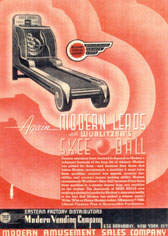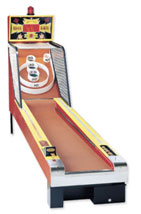
Vol. IX, No. 9, October / November 2009
- Editor's travelogue: my round-the-world trip
- IAAPA Attractions Expo, November 16-20
- Did entertainment spending really grow in 2008?
- Customized cookies, baked in 2 minutes
- Mass customization in Vietnam
- Attractive female staff could be bad for business
- HOOTERS opens its 1st bowling center
- BellaBoo's gets great reviews
- Soft-modular-play on wheels
- Quarter results for two location-based entertainment chains
- Skee-Ball celebrates 100th anniversary
- Families' favorite restaurants
- Upcoming presentations
Skee-Ball celebrates 100th anniversary
Skee-Ball is celebrating its 100th anniversary. Learn about this classic game's history.
 We call a game or attraction that lasts a century a true classic. This year Skee-Ball is celebrating its 100th anniversary, putting it in the true classic league. There aren’t many games or attractions in the location-based entertainment industry that have lasted that long. Interestingly, the ones that have, mainly bowling and billiards, also have a ball that is rolled. Another one, that is not quite as old that dates back to the early 1900’s, perhaps as early as 1916, is miniature golf. Again there is a ball that you roll.
We call a game or attraction that lasts a century a true classic. This year Skee-Ball is celebrating its 100th anniversary, putting it in the true classic league. There aren’t many games or attractions in the location-based entertainment industry that have lasted that long. Interestingly, the ones that have, mainly bowling and billiards, also have a ball that is rolled. Another one, that is not quite as old that dates back to the early 1900’s, perhaps as early as 1916, is miniature golf. Again there is a ball that you roll.
Skee-Ball was invented in 1909 by J.D. Estes in the city of Philadelphia. In 1935 the rights to Skee-Ball were purchased by the Wurlitzer Corporation, which in 1945 sold them to the Philadelphia Toboggan Company, an amusement park ride manufacturer and today the world’s oldest roller coaster company. In 1977 the Philadelphia Toboggan Company set up Skee-Ball, Inc. to market the game, the company that continues to manufacture Skee-Balls.
When Skee-Ball alleys were first sold in 1914 to the outdoor amusement park industry, the game had a 36-foot long lane. This was much too long for most arcades and meant that only people who were quite strong could play it well. As a result, in 1928 it was changed to 14 feet and then in 1981, it was changed to the modern length of 10 feet. Soon after these changes, Skee-Ball became very common in arcades around the United States.
 The original game didn’t have a ticket dispenser. Instead, an attendant would hand you the tickets based on your score. In 1984 additions such as sound effects, musical selections, new electronic componentry were added, which gave the operator the ability to reprogram all game settings at their location. This further increased the popularity and profitability of the game. In 1998 four new versions of the alleys were introduced to the market. Current versions include ICE Ball and Smart Ball.
The original game didn’t have a ticket dispenser. Instead, an attendant would hand you the tickets based on your score. In 1984 additions such as sound effects, musical selections, new electronic componentry were added, which gave the operator the ability to reprogram all game settings at their location. This further increased the popularity and profitability of the game. In 1998 four new versions of the alleys were introduced to the market. Current versions include ICE Ball and Smart Ball.
The original balls were wood, exactly 3 & 1/8 inches in diameter and made from the compressed sawdust left over from cutting the wood for the lanes. Today, the balls are plastic. It is estimated that about 100,000 Skee-Ball games are currently in operation in bars, arcades and entertainment centers throughout the world. Chuck E. Cheese's is the largest buyer and operator of Skee-Balls.
Because prizes were given to the players, in its early days the game was considered a form of gambling in some parts of the country. This led to restrictions on the number of machines allowed in an arcade in some places, and banning of the game in other places. These laws, however, did not last long, and thus Skee-Ball is now found in almost all arcades and gamerooms in the Americas and much of the world.
Vol. IX, No. 9, October / November 2009
- Editor's travelogue: my round-the-world trip
- IAAPA Attractions Expo, November 16-20
- Did entertainment spending really grow in 2008?
- Customized cookies, baked in 2 minutes
- Mass customization in Vietnam
- Attractive female staff could be bad for business
- HOOTERS opens its 1st bowling center
- BellaBoo's gets great reviews
- Soft-modular-play on wheels
- Quarter results for two location-based entertainment chains
- Skee-Ball celebrates 100th anniversary
- Families' favorite restaurants
- Upcoming presentations


